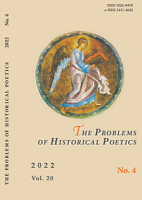Готический злодей и байронический герой
Gothic Villain and Byronic Hero
Author(s): Elena N. KornilovaSubject(s): Studies of Literature, Theory of Literature
Published by: Петрозаводский государственный университет
Keywords: Gothic novel; demonic villain; closed chronotope; Byronic hero; world sorrow; skepticism; melancholy;
Summary/Abstract: The article provides a vivid comparison of the poetic devices developed by the authors of the Gothic novel with the models used by J. G. Byron in “Child Harold’s Pilgrimage” and the “Oriental Poems” cycle. The relationship between the Gothic villain and the Byronic hero is noted; perhaps they are even two facets of the same heroic type. They are both haunted by loneliness and alienation from society; both of these types are generally “scapegoats” or guilt-ridden wanderers. Such a heroic type is characterized by rebelliousness, a mysterious past, a painful struggle between good and evil in his soul. At the same time, the Byronic character is an absolutely modern type, while the Gothic villain is immersed in a conditional fantastic or historical context. Together with the Gothic protagonist, Byron’s texts acquire the plot collisions of the “black novel,” a closed chronotope, and romantic psychologism. After the appearance of Byron’s dramas, the “Byronic hero” archetype was formed, which became synonymous with the concept of “antihero” in English criticism, while in Russia it has different semantics: “superfluous person,” the product of “suffering and doubt.” The Byronic hero embodies the theme of metaphysical rebellion, conflict with the universe and the suffering associated with it. Through Byronic heroes, Byron most consistently stated that “world sorrow” is an inevitable product of time, its spiritual outcome.
Journal: Проблемы исторической поэтики
- Issue Year: 20/2022
- Issue No: 4
- Page Range: 90-111
- Page Count: 22
- Language: Russian

